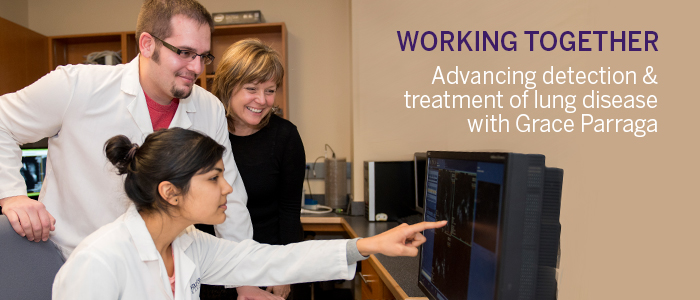Grace Parraga

"I feel a deep sense of pride teaching and doing research at my alma mater,” said Grace Parraga, PhD, professor, Department of Medical Biophysics and researcher, Robarts Research Institute. “I want to provide our students with the same rigorous training I received, enabling them to venture out into the world and compete for the best positions available while demonstrating the tremendous value of a Western University education.”
Parraga graduated with her MSc, in 1986 from the Department of Biochemistry. From there, she completed her PhD at the University of Washington and a postdoctoral position at the Biozentrum at the University of Basel. What followed was a career path some might view as unorthodox.
After spending five years working with industry at Hoffman La Roche in Switzerland, Parraga returned to London in 1998 taking on an administrative role at Robarts Research Institute. A year later she joined the faculty at Western, and began her own research program at Robarts five years later.
Today, her lab is the only place in Canada where imaging research is underway to evaluate early detection of chronic obstructive pulmonary disease (COPD) before clinical diagnostic tools reveal disease.
“Because our lungs are over-engineered for day-to-day tasks, lung disease progresses slowly and silently for a long period of time before the actual effects are recognized by the patient, and before it is diagnosed using traditional methods,” said Parraga.
Using hyperpolarized gases, conventional proton MRI and other pulmonary imaging methods in patients who are ex-smokers, her lab is able to show the areas of the lung where the disease is present, and distinguish between disease of the airway versus disease of the air sacs or alveoli.
This is critical for disease management because the course of treatment can be different depending on which area of the lung is affected. “We want to better understand the different components of smoking-related lung disease so that treatments can be designed that are specific to the type of disease,” she said.
Parraga attributes much of the progress she has had in her lab to the students, fellows and residents who carry out the day-to-day work. The eleven trainees from across a range of disciplines, from Medical Biophysics to Respirology, have to be both independent and interdisciplinary in their work.
Throughout her career, Parraga has supervised 22 graduate students and 12 postdocs and residents. Her advice to them and to all graduate and postdoctoral students; "Find your passion, and network, network, network."








